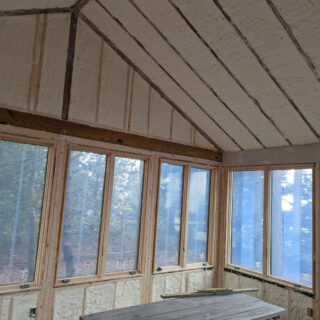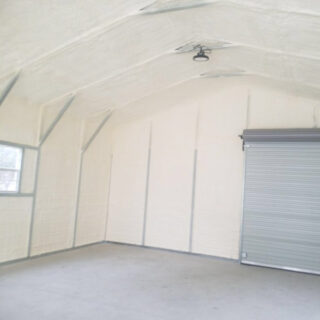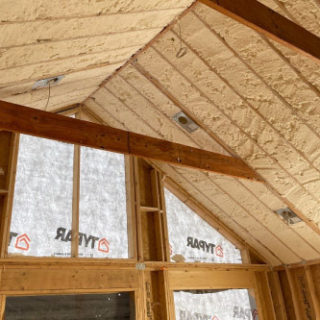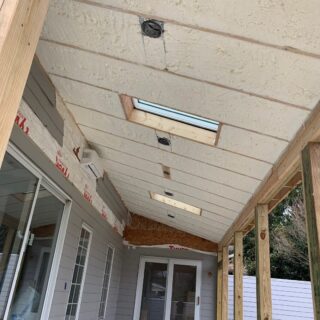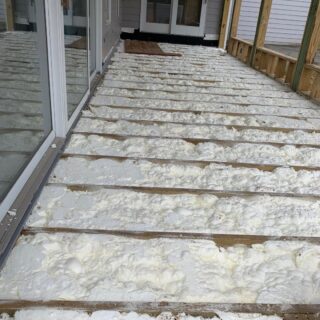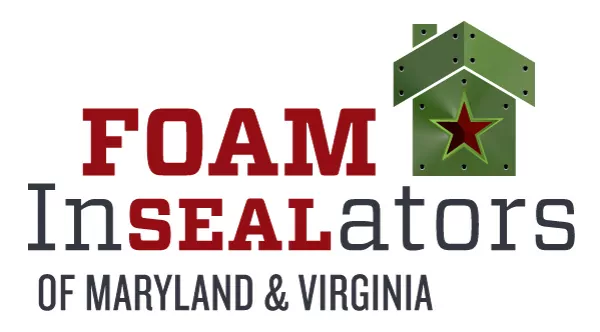If you’re wondering about your next home improvement project and want to make your home more efficient and durable, spray foam insulation is the right choice!
If you’re not familiar with spray foam insulation, think of a foam coffee cup or a foam ice chest. Both products can keep in heat and cold, while protecting the exterior from transferring temperature inside the vessel. Spray foam insulation under siding does exactly the same thing for your house.
Installing foam insulation doesn’t just insulate your home in the same way as fiberglass, cellulose, or other insulation products—it also seals air leaks. Why does this matter? Proper sealing with foam insulation prevents conditioned inside air from escaping through cracks and crevices, and it also prevents unconditioned air from finding its way into the spaces you’re paying to keep comfortable.
These cracks and crevasses exist in places where you can’t always see them—around recessed (can) lights, plumbing stacks, electrical wires, attic hatches or doors, chimneys or flues, and duct chases. Installing foam insulation fills every one of those points of escape, which means the conditioned air you’ve already paid for stays inside your home.
There are two types of insulation made from spray foam:
Open cell spray foam insulation works as an insulator and an air barrier. The typical R-value of open cell foam is 3.6 to 4.45 per inch. Other features of open cell spray foam insulation are that:
- It is vapor permeable
- It is able to accommodate movement from season to season
- It is not a food source for mold
- It dampens sound both inside and outside of the home
As with open cell spray foam insulation, closed cell spray foam also works as both an insulator and air barrier. The Typical R-value of closed cell foam is 7 per inch. Other features of closed cell spray foam insulation are:
- Closed cell foam insulation is denser and therefore insulates better throughout your home.
- High R-value, which offers an added layer of protection to heat flow.
- Ideal for many different areas of your home, especially the hard-to-reach areas such as attic doors, tight corners, etc. of your basement.
- While other insulation materials may lose their effectiveness over time, closed cell spay foam does not.
Benefits of Spray Foam Insulation
In addition to this energy-efficient insulation’s ability to insulate and seal air leaks at the same time, spray foam insulation has a host of other benefits for home insulation. The benefits include:
- Easy installation. The spraying application allows the insulation to access tight spaces and fill them more completely than is possible with fiberglass batts.
- Reduced mold potential. Spray foam insulation isn’t a food source for mold, so it’s perfect for basement insulation where you might be worried about dampness and mold growth.
- Savings on your energy bill. Spray foam is extremely energy-efficient insulation, filling air leaks in your home and insulating it from the elements. That energy saved turns into money saved on your energy bills.
- Strengthened walls. Using closed-cell spray foam insulation in your walls helps strengthen buildings due to their rigidity, helping your home or business hold up in storms.
- Sealing against moisture and pests. Spray foam insulation seals all the tiny gaps where air, moisture, and pests can get in.
- Noise dampening. Open-cell spray foam can keep your home quieter, helping to reduce noise transfer from neighbors and other rooms.
If you’re wondering about your next home improvement project and want to make your home more efficient and durable, spray foam insulation is the right choice!
If you’re not familiar with spray foam insulation, think of a foam coffee cup or a foam ice chest. Both products can keep in heat and cold, while protecting the exterior from transferring temperature inside the vessel. Spray foam insulation under siding does exactly the same thing for your house.
Installing foam insulation doesn’t just insulate your home in the same way as fiberglass, cellulose, or other insulation products—it also seals air leaks. Why does this matter? Proper sealing with foam insulation prevents conditioned inside air from escaping through cracks and crevices, and it also prevents unconditioned air from finding its way into the spaces you’re paying to keep comfortable.
These cracks and crevasses exist in places where you can’t always see them—around recessed (can) lights, plumbing stacks, electrical wires, attic hatches or doors, chimneys or flues, and duct chases. Installing foam insulation fills every one of those points of escape, which means the conditioned air you’ve already paid for stays inside your home.
There are two types of insulation made from spray foam:
Open cell spray foam insulation works as an insulator and an air barrier. The typical R-value of open cell foam is 3.6 to 4.45 per inch. Other features of open cell spray foam insulation are that:
- It is vapor permeable
- It is able to accommodate movement from season to season
- It is not a food source for mold
- It dampens sound both inside and outside of the home
As with open cell spray foam insulation, closed cell spray foam also works as both an insulator and air barrier. The Typical R-value of closed cell foam is 7 per inch. Other features of closed cell spray foam insulation are:
- Closed cell foam insulation is denser and therefore insulates better throughout your home.
- High R-value, which offers an added layer of protection to heat flow.
- Ideal for many different areas of your home, especially the hard-to-reach areas such as attic doors, tight corners, etc. of your basement.
- While other insulation materials may lose their effectiveness over time, closed cell spay foam does not.
Benefits of Spray Foam Insulation
In addition to this energy-efficient insulation’s ability to insulate and seal air leaks at the same time, spray foam insulation has a host of other benefits for home insulation. The benefits include:
- Easy installation. The spraying application allows the insulation to access tight spaces and fill them more completely than is possible with fiberglass batts.
- Reduced mold potential. Spray foam insulation isn’t a food source for mold, so it’s perfect for basement insulation where you might be worried about dampness and mold growth.
- Savings on your energy bill. Spray foam is extremely energy-efficient insulation, filling air leaks in your home and insulating it from the elements. That energy saved turns into money saved on your energy bills.
- Strengthened walls. Using closed-cell spray foam insulation in your walls helps strengthen buildings due to their rigidity, helping your home or business hold up in storms.
- Sealing against moisture and pests. Spray foam insulation seals all the tiny gaps where air, moisture, and pests can get in.
- Noise dampening. Open-cell spray foam can keep your home quieter, helping to reduce noise transfer from neighbors and other rooms.
Why Choose Spray Foam?
Watch this video to learn about some of the benefits of using spray foam insulation when building a new home or remodeling your existing home.
Financial Savings
Energy prices are projected to nearly double in the next two decades. Homes that are traditionally insulated, under insulated or do not have air sealing will generate energy bills that will be difficult for homeowners to afford. Spray foam insulation can decrease energy bills by up to 40%.
Thermal Barriers
Foam InSEALators installs both open cell and closed cell spray foam insulation from the following companies:
- SES: SES Spray Foam – SucraSeal™ and EasySeal™ Open Cell Spray Foam, and Nexseal™ 2.0 Closed Cell Spray Foam provide energy efficiency, comfort, and peace of mind for the life of the building.
- Huntsman: As the fastest growing building insulation product globally, SPF can help reduce energy costs in new and existing buildings by as much as 50%. SPF functions as both an insulant and an air sealing product, thereby reducing energy loss due to air infiltration.
- JM Corbond: JM Corbond is a closed cell spray foam insulation. JM acquired the Corbond line in 2009, adding this product to their array of fiberglass insulation products. JM Corbond IV can be used either alone or in hybrid systems with JM fiberglass to create a custom house insulation application for any use.
- ICP HandiFoam: ICP’s product range includes low pressure spray foam insulation in both refillable and disposable systems, sealants, a line of polyurethane-based spray adhesive products, pour-in-place insulation systems, and specialty products recognized for outstanding performance where fire, smoke, and toxicity issues are of critical concern.
- SWD: SWD’s Quick-Shield Spray Foam insulation and roofing products are specifically engineered to meet the toughest building code standards. All Quick-Shield products including roofing, insulation, and coating solutions, are ICC and/or CCMC approved and are technically superior for traditional building needs.
Ready to talk to one of our seasoned foam specialists? Contact us for a free estimate today. Our team will help you understand all your options so you can make your home more comfortable, durable, and energy efficient.


